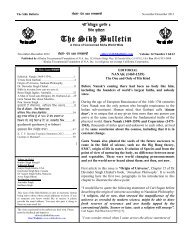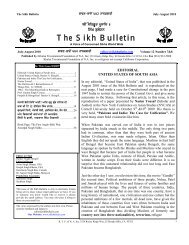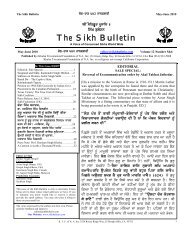Create successful ePaper yourself
Turn your PDF publications into a flip-book with our unique Google optimized e-Paper software.
<strong>The</strong> <strong>Sikh</strong> <strong>Bulletin</strong> hwV-swvx 537 June-July 2005<br />
program at one Gurdwara, the Gurdwara’s take was<br />
$90,000.00. What would be the ‘Sant’s’ take When are we<br />
going to learn a better way to spend our community’s<br />
resources Would we live to see that day<br />
Hardev Singh Shergill<br />
1. mskIn jI dw igAwnI Bwg isMG nwl DoKw p25<br />
2.<br />
mskIn jI dw kOm nUM AwKrI snyhw p24<br />
3 Giani Sant Singh Maskeen 15<br />
4. <strong>Sikh</strong>ism, a Universal World Faith p.5<br />
5. SB March 2004 Guest Editorial by Gurpal Singh Khaira<br />
6. p.4<br />
*****<br />
GURDWARA<br />
[From <strong>The</strong> Encyclopaedia of <strong>Sikh</strong>ism]<br />
GURDWARA, lit. the Guru's portal or the Guru's abode, is<br />
the name given to a <strong>Sikh</strong> place of worship. <strong>The</strong> common<br />
translation of the term as temple is not satisfactory for, their<br />
faith possessing no sacrificial symbolism, <strong>Sikh</strong>s have neither<br />
idols nor altars in their holy places. <strong>The</strong>y have no sacraments<br />
and no priestly order. <strong>The</strong> essential feature of a gurdwara is<br />
the presiding presence in it of <strong>Sikh</strong> Scripture, the Guru<br />
Granth Sahib. Ending the line of personal Gurus, Guru<br />
Gobind Singh, Nanak X, had installed the sacred volume in<br />
1708 as his eternal successor. <strong>The</strong> Holy Book has since been<br />
the Guru for the <strong>Sikh</strong>s and it must reign over all <strong>Sikh</strong> places<br />
of worship where religious ceremony focusses around it. <strong>The</strong><br />
basic condition for a <strong>Sikh</strong> place to be so known is the<br />
installation in it of the Guru Granth Sahib. Every <strong>Sikh</strong> place<br />
by that token is the house of the Guru. Hence the name<br />
Gurdwara (gur+dwara= the guru's door).<br />
A second characteristic of a gurdwara is its being a public<br />
place open to all devotees to pray individually or to assemble<br />
in congregation. Its external distinguishing mark is the<br />
Nishan Sahib or the <strong>Sikh</strong> flag, saffron or blue in colour, that<br />
flies day and night atop the building, or, more often, separately<br />
close to it. In early <strong>Sikh</strong>ism, the place used for<br />
congregational prayers was called dharamsala, the abode of<br />
dharma, from the modern usage which generally limits the<br />
term to a resting place. According to the janam Sakhis, Guru<br />
Nanak wherever he went, called upon his followers to<br />
establish dharamsalas and congregate in them to repeat<br />
God's Name, and to recite His praise. He himself established<br />
one at Kartarpur on the bank of the river Ravi where he<br />
settled down at the end of his extensive preaching tours. "I<br />
have set up a dharamsal of truth," sang Guru Arjan (1563-<br />
1606). "I seek the <strong>Sikh</strong>s of the Guru (to congregate therein)<br />
so that I may serve them and bow at their feel" (GG, 73). In<br />
the time of Guru Hargobind (1595-1644), dharamsals began<br />
to be called gurdwaras.<br />
<strong>The</strong> change of nomenclature was significant. Guru Arjan had<br />
compiled in 1604 a Book, pothi or granth (later Guru Granth<br />
Sahib) of holy hymns. Besides his own, he had included in it<br />
the compositions of his four spiritual predecessors and of<br />
some of the Indian saints and sufis. "<strong>The</strong> pothi is the abode<br />
of the Divine," said he (GG, 1226). This first copy of the<br />
Granth he installed in the central <strong>Sikh</strong> shrine, the<br />
Harimandar, at Amritsar. Copies of the Granth began to be<br />
piously transcribed. <strong>The</strong> devotees carried them on their<br />
heads for installation in their respective dharamsals.<br />
Reverently, the Book was called the Granth Sahib and was<br />
treated as a sacred embodiment of the Gurus' revealed<br />
utterances. <strong>The</strong> dharamsal where Granth Sahib was kept<br />
came to be called gurdwara. <strong>The</strong> designation became<br />
universal after the guruship passed to the holy Book,<br />
although the central shrine at Amrilsar continued to be<br />
called Harimandar or Darbar Sahib.<br />
During the second half of the eighteenth century and after,<br />
as the <strong>Sikh</strong>s acquired territory, gurdwaras sprang up in most<br />
of the <strong>Sikh</strong> habitations and on sites connected with the lives<br />
of the Gurus and with events in <strong>Sikh</strong> history. Most of the<br />
historical gurdwaras were endowed by the ruling chiefs and<br />
nobility intentioned philanthropy, however, in many cases<br />
led to the rise of hereditary priesthood, which was brought<br />
to an end through a sustained agitation culminating in<br />
securing from the Punjab Legislative Council legislation<br />
called the <strong>Sikh</strong> Gurdwaras Act, 1925, providing for the<br />
management of the major historical <strong>Sikh</strong> shrines by a body<br />
known as the Shiromani Gurdwara Parbandhak Committee<br />
elected through adult franchise under government auspices.<br />
This kind of democratic control is a unique ecclesiastical<br />
feature. Most of the shrines not covered by the Gurdwaras<br />
Act are administered by committees chosen by local<br />
sangats. Men and women of good standing in the <strong>Sikh</strong><br />
community may be elected to the gurdwara committee and<br />
anyone, male or female, may become president. As<br />
<strong>Sikh</strong>ism has no priesthood, the Shiromani Gurdwara<br />
Parbandhak Committee provides guidance to the community<br />
in religious matters.<br />
<strong>The</strong> main function of the Gurdwara is to provide <strong>Sikh</strong>s with<br />
a meeting-place for worship. This mainly consists of<br />
listening to the words of the Guru Granth Sahib, singing<br />
them to musical accompaniment and hearing them<br />
expounded in katha, or lectures and sermons. <strong>The</strong><br />
Gurdwara also serves as a community centre, a school, a<br />
guest house for pilgrims and travellers, occasionally a<br />
clinic, and a base for local charitable activities. Apart from<br />
morning and evening services, the gurdwaras hold special<br />
congregations to mark important anniversaries on the <strong>Sikh</strong><br />
calendar. <strong>The</strong>y become scenes of much eclat and festivity<br />
when celebrations in honour of the birth anniversaries of the<br />
Gurus and of the Khalsa take place. <strong>The</strong> aspect of <strong>Sikh</strong>ism<br />
most closely associated with the gurdwara, other than<br />
worship, is the institution of Guru ka Langar or free<br />
community kitchen which encourages commensality. Seva<br />
or voluntary service in Guru ka Langar is considered by<br />
<strong>Sikh</strong>s a pious duty.<br />
K.T.F. of N.A. Inc. 3524 Rocky Ridge Way, El Dorado Hills, CA. 95762 4
















